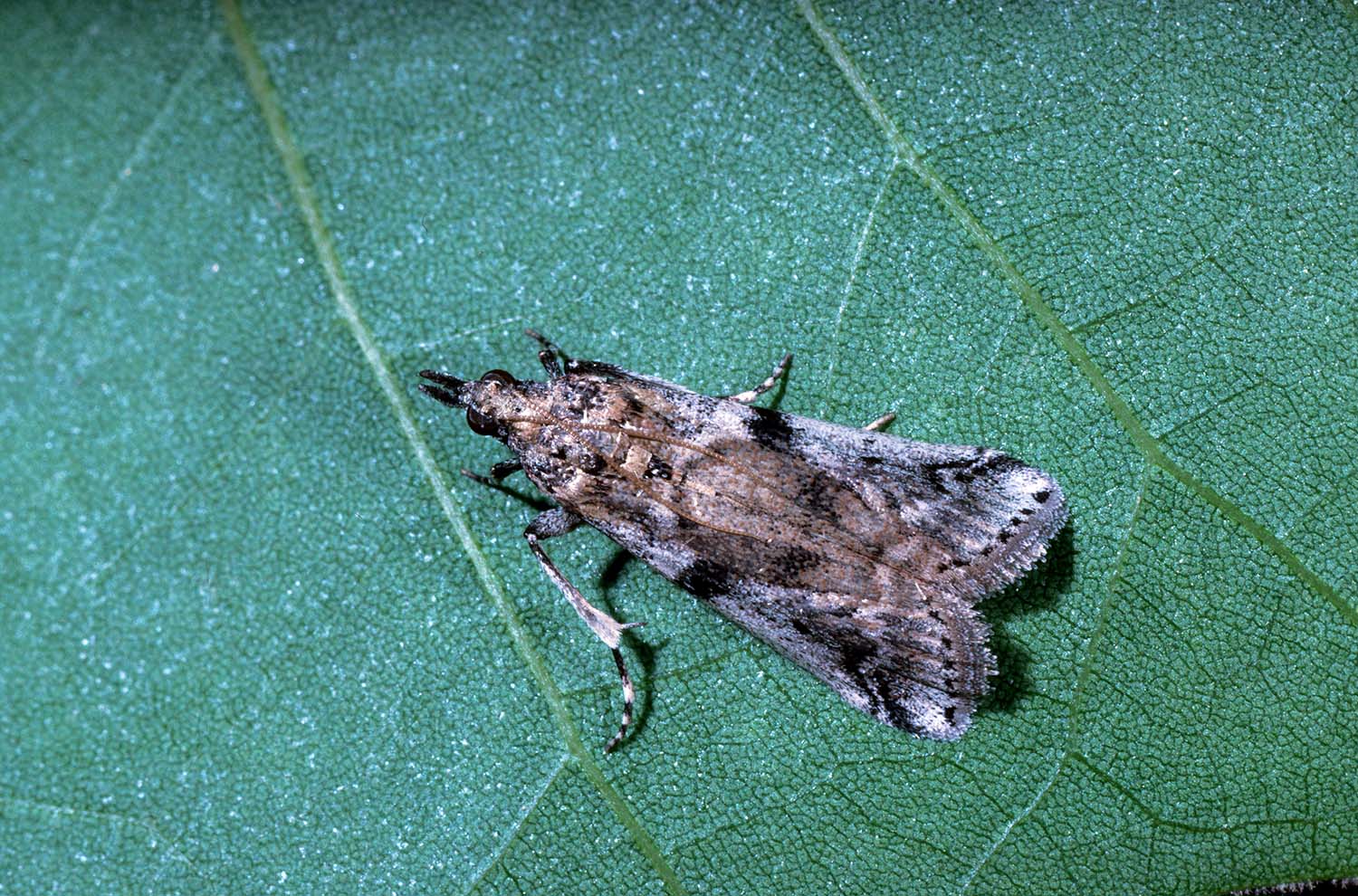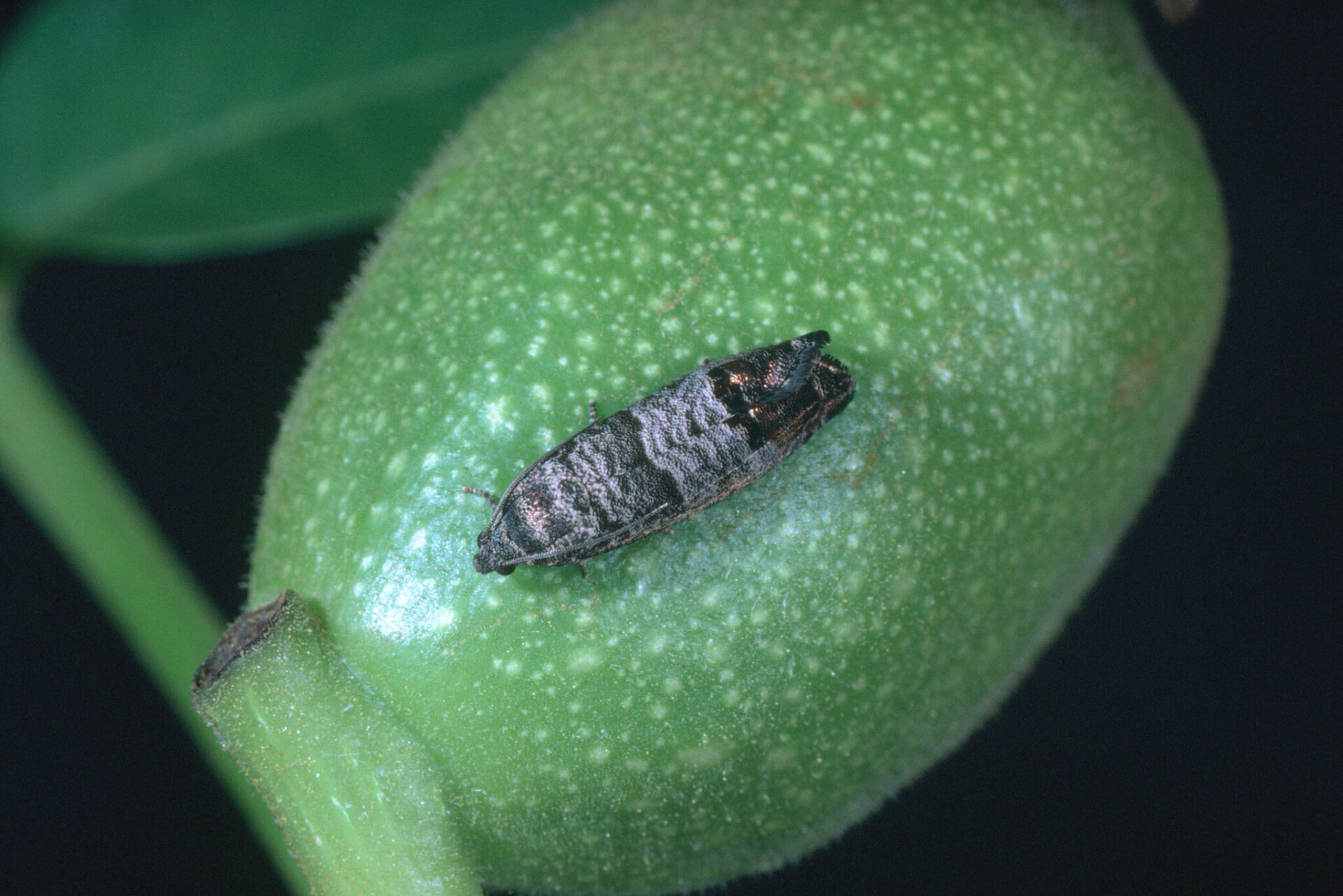
In principle, an area-wide integrated pest management program (AW-IPM) is a coordinated effort to target an entire pest population over a region with coordinated IPM tactics. AW-IPM, like IPM itself, is an ideal to be approached rather than a recipe to be followed. The USDA sterile insect technique (SIT) program to eradicate the New World screwworm is perhaps the best-known program of this type.
The USDA-ARS AW-IPM program provides supplementary funding to USDA researchers and collaborators for five-year demonstration programs used to show how new or improved technology can be used. Grower and industry support is a prerequisite. A five-year USDA-ARS AW-IPM program from 1995 to 2000 demonstrated and expanded mating disruption for the codling moth (CM) as a pest of apples and pears in the states of Washington, Oregon and California. During this period, the acreage under mating disruption for CM expanded from ca. 2,600 to >20,000 acres.
In California in the early 2000s, tree nut acreage (almonds, pistachios and walnuts) was expanding rapidly. The navel orangeworm (NOW) is the most economically important insect pest of almonds and pistachios and is an economically important pest for walnuts, too. Brad Higbee had a key role in the execution of the USDA-ARS CM program in Washington State and was recruited by Wonderful Orchards (WO, then known as Paramount Farming) to lead and coordinate their R&D efforts for mating disruption and IPM for NOW.
AW-IPM for NOW: Baseline Knowledge
Up until the year 2000, mating disruption for NOW appeared to be a dubious venture. The sex pheromone was incompletely characterized, and the single known component was not adequate to efficiently attract NOW to a point source. The central paradigm for mating disruption at the time was that it was best accomplished by efficiently attracting males to widely dispersed point sources, and that an optimized pheromone blend was the best starting point for such efforts.
Harry Shorey, one of the leaders in 20th-century moth pheromone research, offered an alternative vision. He showed that high amounts of CM and NOW pheromone, diffused passively, could suppress male response to “calling” females (females releasing sex pheromones) throughout 40-acre blocks. Shorey’s Puffer® (aerosol pheromone release device), while one of several competing devices, was the first one commercialized. WO developed the device with Shorey and mass-produced it.
After Shorey’s untimely death in 1998, Charles Burks began studies using these newly available Puffers® to reduce NOW in figs in central California. Soon after Higbee moved from USDA-ARS to WO in 2002, he began collaborating with Burks, who provided large quantities of unmated females to test the ability of various formulations to suppress mate-finding and mating.
From 2003 to 2008 a series of experiments at WO conducted by Higbee and Burks determined the best of the available approaches for suppressing NOW mating and damage. Research examining the effects of mating disruption on NOW biology and mating were conducted in pistachios and almonds, but damage was primarily investigated in almonds because the relationship between NOW abundance and damage was more direct. Comparison of Puffers® and early passive release devices indicated the former were more efficacious. Comparison of Puffers® placed on the periphery of 40-acre treatment blocks and Puffers® gridded throughout these blocks indicated that the small differences in mating suppression observed in these experiments were correlated with significant differences in damage to almonds. This research provided the basis for commercial registration of the Puffer® in 2008. In addition, work in the laboratory of Walter Leal at UC Davis provided preliminary identification of additional sex pheromone components important to an attractive blend.
Components of the Area-Wide Program
Based on these data and the impending registration of the Puffer® for NOW, Higbee approached the USDA-ARS leadership in Washington D.C. about implementing an area-wide project like the CM program in which he had previously participated. The Parlier lab was chosen as the logical central location, and Joel Siegel was nominated by location leadership to lead the proposal. Siegel immediately corresponded with the leadership of the Almond Board of California, the California Pistachio Research Board and the California Walnut Board as well as program leadership within USDA-ARS in order to develop a proposal.
The project that Siegel drafted involved demonstration projects in southern, central and northern California involving use of mating disruption along with a best practices program of sanitation, timely harvest, monitoring and use of reduced-risk insecticides. Along with Burks’ continuing role, Parlier USDA-ARS colleague Bas Kuenen examined optimization of monitoring. UC Berkeley Entomologist Stephen Welter helped to extend CM mating disruption in walnuts, while UC Berkeley Entomologist Kent Daane examined the effect of mating disruption and reduced insecticides on natural enemies. UC Davis Entomologist Frank Zalom conducted ancillary demonstration research on pest practices in the Sacramento and northern San Joaquin valleys, while UC Davis Plant Pathologist Themis Michaillides examined the association between NOW and almond fungi that produce aflatoxins. UC ANR Economist Karen Klonsky examined cost and return associated with the new practices, while Farm Advisors Bob Beede (San Joaquin Valley) and Carolyn Pickel (Sacramento Valley) extended the demonstration project results in their areas.
Two large demonstration projects in Kern County WO orchards examined different visions of implementation of NOW mating disruption. The 2,700-acre Santa Fe project evaluated the use of mating disruption and cultural control as the sole means of NOW control (with occasional insecticide use along the edges of the orchard.) The 2,400-acre Lost Hills project systematically compared the density of Puffers® used and the presence or absence of insecticide applications. Burks coordinated a 2,300-acre demonstration project in western Fresno County in concert with Independent PCA Mike Strmiska, who was an early adopter of NOW mating disruption and in turn coordinated the efforts of independent almond growers in several adjacent orchards. Welter and Pickel organized a walnut demonstration project in the Sacramento Valley.

Research and Collaboration
The USDA-ARS NOW AW-IPM program included ancillary research in addition to the primary goal of demonstration and technology transfer of mating disruption. Higbee collaborated with USDA-ARS Researcher John Beck (then in Albany, Calif.) to develop and patent a kairomone blend for monitoring NOW in the presence of mating disruption. Kuenen and Burks, meanwhile, worked on using a previously-identified attractant, phenyl propionate (PPO), for this purpose as well.
Kuenen, Burks and Higbee worked on refining NOW monitoring using ovipositional attractants for females, and Kuenen worked with UC Riverside Entomologists Jocelyn Millar and Ring Cardé to increase the understanding of the pheromone blend. Siegel collaborated with Higbee and with colleagues at University of Illinois, including Professor May Berenbaum, on insecticide application, coverage and resistance. Siegel and Kuenen conducted experiments on larval development time, population dynamics and adult emergence. Burks conducted additional studies on chronobiology and response to pheromone, and Higbee worked with Cardé and UCR Postdoc Robbie Girling to characterize the movement of air and pheromone plumes in tree nut orchards.
Burks and Higbee also collaborated with Cardé on comparing the impact of the full pheromone blend to the major component alone. Klonsky provided a partial cost analysis showing that return with NOW mating disruption was a net positive in three of the five years of the program, and the average return over the five years of the program was positive. Higbee collaborated with Burks to field-test NOW pheromone lures during the final years of the area-wide program.
Program Outcomes, Advances and Challenges
The increased adoption of mating disruption for NOW was the clearest program outcome. At the time the program began, approximately 1,500 acres were under mating disruption for NOW. By 2014, the estimate was 100,000, and by 2019, there were 500,000 acres under NOW mating disruption, a more than 300-fold increase.
The ancillary research conducted during the NOW AW-IPM program advanced monitoring and insecticide control of NOW as illustrated by 24 peer-reviewed papers and patents, which can be found at github.com/ChuckBV/Y2008_to_2012_navel_orangeworm_areawide. A commercial pheromone lure for NOW first became available the year after the program ended. Ironically, its importance was diminished by the adoption of mating disruption and the long distance over which it suppressed pheromone traps.
Analysis of data collected during and after the AW-IPM project (research at the Lost Hills site continued another three years) found that female attractants (egg traps or ovipositional baits) were more correlated with damage than male capture in pheromone traps. The female traps, however, have the disadvantage of low detection sensitivity, and egg traps are particularly labor intensive. Research funded by the Almond Board of California found that PPO provides more robust detection of NOW in the presence of mating disruption, and lures based on that attractant were commercialized. There are drawbacks to using PPO because of the strong odor associated with the lures, and trap counts are sometimes complicated by captures of moths similar to NOW in size and color. Monitoring therefore remains an active area of research.
Within a few years of the end of the NOW AW-IPM project, two more aerosol mating disruption formulas and a “meso-dispenser” formulation became available. One of these aerosol dispensers had additional programming features which allowed experiments to be conducted that revealed a non-competitive mechanism for NOW. This non-competitive mechanism makes mating disruption for NOW less density-dependent than a competitive mechanism, such as is found with CM. These experiments also indicated that emission prior to most mating activity is probably not beneficial and that the disruption mechanism depends more on desensitizing the male to female-emitted pheromone rather than just camouflaging the female plumes from the male. Subsequent research by David Haviland and collaborators in Kern County demonstrated that each of these four formulations is effective and indicated a break-even point of 0.8% to 1.1% NOW kernel damage.
The AW-IPM program provided examples of independent growers coming together to implement mating disruption. This example has, however, been followed more readily in places like the west side of the San Joaquin Valley where, on average, land parcels are larger, and NOW is more abundant. Industry groups like the Almond Board of California have continued to promote further adoption of mating disruption, but coordination of and incentives for small growers remain problematic.
Overall, the 2008-12 USDA-ARS Area-wide Project illustrated the importance of starting with solid baseline research and development (R&D) and proceeding incrementally. However, while a solid R&D base is important before scaling up, empirical data showing that this technology could achieve the desired objectives (reduced mating, reduced damage) proved more important than theoretical underpinnings. In the case of NOW, advances in the theoretical framework contributed to understanding how mating disruption worked, but the demonstration that it did work preceded an understanding of the exact mechanism.
The case of mating disruption for control of NOW also demonstrated that economics trumps biology. A technology like mating disruption must have a plausible mechanism to function, but it is also possible that an inefficient mechanism used in a high-value crop will provide greater economic return than a very efficient mechanism that is more expensive or implemented in a lower-value crop. Finally, the social challenges are generally more limiting than the technical challenges in developing or expanding AW-IPM programs.










